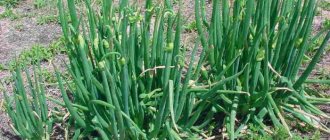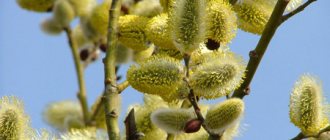Author: Natalya Category: Garden plants Published: February 20, 2019Republished: February 20, 2019Last edits: November 03, 2020
- Growing conditions
- Preparing for winter
- Giant Miscanthus (Miscanthus giganteus)
plant (lat. Miscanthus) , or fan , is a close relative of sugar cane and belongs to the genus of herbaceous perennials of the Poa family (Poaceae), common in the subtropical and tropical regions of Asia, Australia and Africa. There are about 40 plant species in the genus. In cultivation, miscanthus grass is one of the most popular ornamental grasses. Miscanthus in landscape design is used to decorate ponds, lawns, and also to create dry floral compositions.
Planting and caring for miscanthus
- Planting: from late March to mid-May.
- Flowering: in the second half of summer.
- Lighting: bright sunlight.
- Soil: moist, fertile, near a pond. Miscanthus does not grow well on heavy clay and sand.
- Watering: regularly and abundantly, using a hose.
- Feeding: regular and moderate, three times per season, starting from the second year: in mid-May - with urea solution, in the first half of summer - with humates, in the second - with potassium-phosphorus fertilizers.
- Reproduction: by seeds, but more often by dividing the bush in the spring.
- Pests and Diseases: The plant is extremely resistant to both diseases and pests.
Read more about growing miscanthus below.
Botanical description
Miscanthus flower is a perennial with a height of 80 cm to 2 m with creeping rhizomes, which in search of food can reach a depth of 6 m, erect shoots, scaly leathery leaves 5 to 18 mm wide and fan-shaped panicles 10 to 30 cm long, consisting of spikelets . Miscanthus is unpretentious, hardy and environmentally friendly; it is of interest not only for its decorative value, but also as a fuel for power plants, since during its combustion a large amount of energy is released with the formation of a minimal amount of ash due to the low moisture content in the raw material.
Planting miscanthus
When to plant
Miscanthus is planted in the spring, when the soil warms up - from late March to mid-May. Miscanthus are heat-loving, so they need to be planted in well-lit and sun-warmed areas, protected from cold winds. But even more than warmth, miscanthuses love water, which is why they prefer moist, fertile coastal areas. The quality of the soil for miscanthus is not very important, but they grow worst of all on sand and heavy clays.
How to plant
If you decide to grow miscanthus on your plot, buy adult seedlings: this plant has a very long growing season, since heat-loving miscanthus begins to grow only when the air temperature reaches 25 ºC, so a young seedling simply will not have time to take root and grow stronger before the onset of cold weather.
- How to root roses in potatoes
An adult seedling has a greater margin of safety, and with good shelter it can survive even a cold winter without pain. A layer of fertile soil is placed in the planting hole, which should be slightly larger in volume than the root system of the seedling, then the seedling is lowered into it and the voids are filled with soil, gradually compacting it. After planting, miscanthus is watered abundantly.
Conditions for growing miscanthus: place, soil and neighbors.
PLACE. Miscanthus grows well in full sun. When choosing a place for planting, leave a lot of space for the plant, because even one miscanthus bush will require a lot of space.
The best flowerbed neighbors for miscanthus are:
- Hibiscus
- Sunflower,
- Meadowsweet
- Dahlia / Dahlias
The SOIL for growing miscanthus should be well-drained, but not waterlogged. The plant tolerates acidic and heavy clay soils well.
Miscanthus indeed grows in a variety of soils over a wide pH range, but the optimal pH is between 5.5 and 7.5. The fallen leaves of the plant itself are an excellent fertilizer for it. Some farmers in Western countries specifically grow miscanthus to produce biomass, which is used as natural fertilizers and also as natural fuel. 20 tons of miscanthus is equivalent to 8 tons of coal.
Caring for miscanthus in the garden
Growing conditions
Plant lovers say that there is no worse sight than a drying miscanthus, so do not forget to water it, especially during the hot, dry season. It is best to water miscanthus with a hose - the more abundantly, the better. Growing miscanthus also requires regular but moderate feeding, since excess nitrogen, for example, leads to lodging of the plant.
In the first year, miscanthus is not fed, and then fertilizers are applied twice per season: in mid-May, liquid fertilizing with nitrogen fertilizers - for example, a urea solution - will be required. In the first half of summer, the area is watered with humates, and in the second half, potassium-phosphorus fertilizers are applied. When starting to grow miscanthus, be prepared for constant weed control, at least in the first two years of the plant’s life. Then, when it gets stronger and grows, the weeds will no longer be able to break through the intensively spreading roots of the miscanthus. But, thanks to the roots of the plant, you will not have to loosen the soil on the site.
By the way, the growth of miscanthus in the garden will have to be limited, otherwise, except for this picturesque reed, nothing else will be able to grow. This is done immediately after planting: the limiter marks the limits within which the plant should remain. You can use pieces of iron or slate as a limiter. They need to be dug in along the entire perimeter of the site, without breaks or gaps, to a depth of at least 20 cm, and they must rise above the surface by at least 10 cm so that the roots, in search of food, cannot “jump over” the line.
By the end of summer, some types of miscanthus lose their lower leaves, and this reduces the decorative value of the plant. To disguise the lower thinning part of the bushes, it is best to plant a tall hosta on the site - 50-60 cm in height, which grows quietly in conditions of excess soil moisture, which miscanthus cannot do without.
That's probably all that can be said about growing this cereal. Planting and caring for miscanthus in open ground is not labor-intensive, and the beauty and effectiveness of this plant can hardly be overestimated.
- Calla tuberous. We asked - we answer
Miscanthus propagation
Miscanthus does not like changing places, but over time the shoots in the center of the bush die off, so there is a need to replant the plant, which is combined with dividing the bush - one of the most reliable vegetative methods of propagating miscanthus. The bush is divided in spring or early summer; the procedure is carried out very carefully, since miscanthus recovers after injury for a long and painful time.
It is also possible to propagate the plant by seed. Miscanthus seeds do not require pre-sowing treatment, however, the generative method of propagation will require patience from you and will take a lot of time, since a plant grown from seeds becomes attractive only in the third or fourth year. The seeds are germinated in peat pots, and with the onset of spring, after the soil has completely thawed, they are planted in open ground. We remind you that when propagated by seed, miscanthus does not retain varietal characteristics, therefore the vast majority of gardeners prefer to propagate miscanthus vegetatively.
Pests and diseases
Nothing is known about diseases and pests that can affect miscanthus. This is a very healthy plant.
Reproduction by dividing the bush
You can get a beautiful fanberry bush by propagation, or rather by dividing the bush.
The procedure can be carried out no more than once every 3-4 years.
The plant itself does not tolerate dividing the bush well and takes a long time to die.
It is best to start dividing in early spring or early summer.
For this:
- Dig up the plant along with the roots. Proceed carefully so as not to damage the root system.
- Clear the roots from the soil and divide into several parts. At the same time, make sure that the root system is powerful, and there should also be young stems on it. It is better to cut with a sharp knife.
- Plant the divisions, divided into several parts, into pre-prepared holes.
- If this is not possible, you can store the cuttings in a cool room for several days.
Note! After transplantation, individual bushes will take a long time to adapt to their new location. This is a normal phenomenon and should not be alarmed. You need to be patient and wait a little. After a while, you will see how the fan will begin to develop, spreading its leaves, reminiscent of a fountain.
You can buy seedlings at the nursery. They can also be found in specialized stores.
When choosing, it is important to pay attention to the condition of the plant. There should be no damage or signs of disease.
Also inspect the soil in the pot, there should be no pests there. The ground may be damp.
Miscanthus after flowering
Preparing for winter
There are types of miscanthus that are resistant to cold, and there are those that require mandatory shelter for the winter. Delicate varieties must be protected not only from frost, but also from sudden temperature changes. If cold weather comes gradually, then the plant has time to adapt to changes in nature, but if frost strikes unexpectedly, it may die. To prevent this from happening, cover the miscanthus with a hut made of film so that air can flow under it from the sides, and install two wooden shields on top of the film, also with a hut - this design will protect the miscanthus from a sudden cold snap.
But do not forget to mulch the area before constructing the shelter and protect the roots from freezing with a thick layer of any loose soil.
Use in landscape design. Preparing for winter
An adult plant also requires preparation for winter. Insulate the soil around the stems with leaves, hay or straw. The ground part is not cut off; it serves as additional insulation. In addition, tall stems retain snow, which serves as an additional heat accumulator in winter and moisture in spring. Dried stems are cut off in the spring to allow young shoots to fully develop.
Miscanthus in garden design
In landscape design, miscanthus is used to decorate ponds. Long leaves hanging over the surface of the water look beautiful like a fountain. Can be used as a hedge. With good care, thanks to its tall stems and density of shoots, such a hedge will cover all unsightly places.
A combination of different types or varieties of miscanthus around a pond will decorate the landscape. Planting miscanthus can be used as a background for a flower bed. In plantings it goes well with daylilies, astilbes, and cornflowers. You can plant peonies, asters, and phlox nearby. The combination of fantail with other lower plants is even recommended. By the end of summer, the lower leaves dry out and have an unsightly appearance. Miscanthus is used in mixborders, as well as for highlighting zones. Single plantings look like an emerald fountain.
Planting miscanthus will give an exotic and unusual look to your site, hide unsightly places, and can serve as a hedge. This type of cereal can be used in winter bouquets. Even in autumn, reddened or silvery panicles go well with yellow leaves. In winter, the panicles will be covered with frost and snow, reminiscent of an illustration from a fairy tale.
Types and varieties
Giant Miscanthus (Miscanthus giganteus)
Most likely, it is a complex hybrid that has long been familiar to gardeners, but whose origin can only be guessed at. Its erect stems reach a height of 3 m, weeping dark green leaves with a white stripe along the midrib up to 25 cm wide, extending from the stem in all directions, make the plant look like a large fountain. This species blooms in late summer with pinkish panicles, which become silvery over time, and in areas with cold summers, giant miscanthus may not bloom at all.
Most often this view is used as an accent in the background. It requires camouflage of the lower part of the stems due to the leaves dying off in the second half of summer.
- Ampelous plants: planting and care
Chinese Miscanthus (Miscanthus sinensis)
It grows naturally in China, Korea, Japan and Russia. This is a perennial grass with a loose bush, short rhizome and erect stems up to 3 m high. Its leaves are linear, hard and rough, up to 1.5 cm wide, with a rough rib along the midrib. It blooms with single-flowered spikelets up to 7 mm long, collected in loose panicles. The species has been in cultivation since 1875, its winter hardiness is relative, so dry shelter and mulching for the winter are mandatory.
Chinese miscanthus is the most popular species in cultivation; today more than a hundred of its varieties are known, which differ in the color and shape of the inflorescences, the size and outline of the bush. Among them there are both heat-loving plants and those that can be safely grown in the middle zone. For example:
- Blondo - bush height up to 2 m, cold-resistant - winters without shelter;
- Variegatus is a loose bush no more than one and a half meters high with white longitudinal stripes on the leaves;
- Miscanthus Zebrinus, sometimes called Miscanthus Zebrina , is a variegated plant with transverse yellow stripes along green leaves;
- Ferner Austin - up to one and a half meters high, narrow graceful green leaves have a white stripe along the midrib, changing color to reddish-red in the fall. Blooming in August, the fan-shaped bright red panicles with white tips gradually turn silvery-bronze;
- Morning Light is a graceful low plant with narrow leaves edged with white. Unfortunately, this variety blooms late and not every year;
- Strictus is a miscanthus up to 270 cm high with bright variegated leaves up to 1.5 cm wide, along which transverse bright white and green stripes alternate, and reddish single-flowered spikelets in loose panicles.
Miscanthus sacchariflonis (Miscanthus sacchariflonis)
It grows in Russia in damp areas from the Amur region to the south of the Primorsky Territory, as well as in Korea, China and Japan. This is a plant up to 2 m high with bare stems, linear light green drooping leaves up to 60 cm long and up to 1.5 cm wide, blooming with white or silver-pink panicles up to 25 cm long. Since this species is heat-loving, its development begins in late spring, but throughout the warm season, Miscanthus sucrose grows intensively. It blooms from July and remains decorative until October.
It is cold-resistant, overwinters without shelter, but mulching the area in case there is no snow is advisable. The most popular form is Robustus - a plant larger than the main species.











